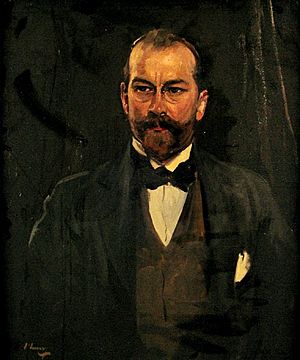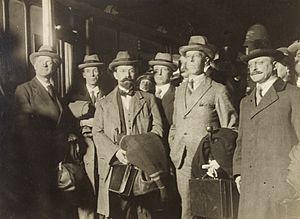George Gavan Duffy facts for kids
Quick facts for kids
George Gavan Duffy
|
|
|---|---|

Portrait of George Gavan Duffy by Sir John Lavery
|
|
| President of the High Court | |
| In office 4 May 1946 – 20 June 1951 |
|
| Nominated by | Government of Ireland |
| Appointed by | Seán T. O'Kelly |
| Preceded by | Conor Maguire |
| Succeeded by | Cahir Davitt |
| Judge of the High Court | |
| In office 2 July 1936 – 20 June 1951 |
|
| Nominated by | Government of Ireland |
| Appointed by | Domhnall Ua Buachalla |
| Minister for Foreign Affairs | |
| In office 10 January 1922 – 25 July 1922 |
|
| President | Michael Collins |
| Preceded by | Arthur Griffith |
| Succeeded by | Arthur Griffith |
| Teachta Dála | |
| In office May 1921 – August 1923 |
|
| Constituency | Dublin County |
| Member of Parliament | |
| In office December 1918 – May 1921 |
|
| Preceded by | Michael Louis Hearn |
| Succeeded by | Constituency abolished |
| Constituency | Dublin South |
| Personal details | |
| Born | 21 October 1882 Rock Ferry, Cheshire, England |
| Died | 10 June 1951 (aged 68) Dublin, Ireland |
| Nationality | Irish |
| Political party | Cumann na nGaedheal |
| Spouse |
Margaret Sullivan
(m. 1908) |
| Children | 2 |
| Parent |
|
| Relatives |
|
| Education | Stonyhurst College |
| Alma mater | University of London |
George Gavan Duffy (born October 21, 1882 – died June 10, 1951) was an important Irish politician, lawyer, and judge. He served as the President of the High Court in Ireland from 1946 to 1951. Before that, he was a judge in the High Court and even the Minister for Foreign Affairs in 1922. He was also a Teachta Dála (TD), which is like a member of parliament in Ireland, and a Member of Parliament (MP) in the UK Parliament.
Contents
Family and Early Life
George Gavan Duffy was born in England in 1882. His father, Charles Gavan Duffy, was a well-known figure in Irish history. George had a half-brother, Frank Gavan Duffy, who became a very important judge in Australia.
His sister, Louise Gavan Duffy, moved to Ireland in 1907. She taught at a school for girls run by Patrick Pearse, a leader in the Easter Rising of 1916. Louise was also involved in the Easter Rising herself and later founded her own bilingual school in Dublin, called Scoil Bhríde, which is still open today. George spent some of his childhood in France and learned to speak Italian and French fluently. He later went to Stonyhurst College for his education.
In 1908, George married Margaret Sullivan, and they had two children, a son named Colum and a daughter named Máire.
Becoming a Lawyer
George Gavan Duffy first became a solicitor, a type of lawyer, and worked in London. A very important moment in his early career was when he defended Sir Roger Casement in his trial. Casement was accused of treason after the Easter Rising. Even though Casement was found guilty, this trial deeply affected Gavan Duffy.
In 1917, he moved to Dublin and became a barrister, another type of lawyer, at King's Inns. This is when he became very involved in Irish politics.
Political Journey
Working for Irish Recognition
In the 1918 election, George Gavan Duffy was elected as a Sinn Féin MP for Dublin South. He was then sent to Paris to represent the newly declared Irish Republic. His job was to convince other countries to recognize Ireland as an independent nation. He wrote articles and pamphlets during the Paris Peace Conference to achieve this.
However, France was an ally of Britain during the First World War and didn't want to upset them. Also, the Irish Republican Army had started the Irish War of Independence against Britain. Because of this, many countries saw the Sinn Féin movement as unfriendly. Gavan Duffy's efforts to get recognition for Ireland were not successful, and he was eventually asked to leave Paris in 1920. He then traveled to other parts of Europe, still trying to gain support for Irish independence.
The Anglo-Irish Treaty

In 1921, Éamon de Valera chose George Gavan Duffy to be part of the team that would negotiate the Anglo-Irish Treaty with Britain. He was chosen because of his strong legal knowledge. Gavan Duffy was not happy about signing the Treaty, but he did so as the last person to sign it.
During the debates about the Treaty in Dáil Éireann (the Irish parliament), Gavan Duffy explained his decision. He said that while he didn't love the Treaty, he believed there was no other good choice for Ireland to move towards independence. He felt that rejecting the Treaty without a clear alternative would be worse for the Irish people. He emphasized that the decision should be based on the idea of "government by the consent of the governed" – meaning what the people of Ireland wanted.
He also disagreed when the draft of the Irish Free State's Constitution was shown to the British Prime Minister, David Lloyd George. Lloyd George insisted on changes, like including references to the King and an Oath of Allegiance. Gavan Duffy didn't believe Lloyd George's threat of war if Ireland refused to sign.
Leaving Political Office
Gavan Duffy resigned from his role as Minister for Foreign Affairs in July 1922. He did this when the government refused to follow a court order to release George Plunkett, who was held without charge during the Irish Civil War.
He resigned again when the government abolished the Republican Courts and executed his friend Erskine Childers. After this, he ran in the 1923 election as an independent candidate but was not re-elected.
Return to Law and Judgeship
After leaving politics, George Gavan Duffy went back to being a barrister in Ireland. He became very successful and worked on important legal cases, especially those dealing with the Irish Constitution. In 1930, he became a Senior Counsel, a higher rank for lawyers.
In 1936, he was appointed a Judge of the High Court. He also advised Éamon de Valera when the 1937 Constitution of Ireland was being written. He helped set up the Seanad Éireann, which is the second house of the Irish parliament.
In 1946, he reached the top of his legal career when he was appointed President of the High Court. He held this important position until his death. One notable case he heard was the Tilson Case in 1950. His ruling in this family law case was based on the special position of the Roman Catholic Church in Ireland in the Constitution at that time.
He was also a member of An Ríoghacht, a Catholic organization.
Death
George Gavan Duffy passed away in Dublin on June 10, 1951.

